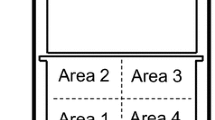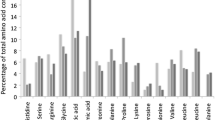Abstract
Honeybee foragers load a small amount of honey into the crop when they leave the hive. This “honey at departure” is used as a material to build pollen loads (glue honey) as well as fuel during flight in pollen foragers. We investigated the relationship between the size of pollen loads that a forager collected and the amount of honey at departure in the Western honeybee, Apis mellifera. Dancing pollen foragers increased honey at departure with the size of collected pollen loads. Analysis of the waggle-run duration revealed that the size of pollen load affected the rate of increase of honey at departure with food source distance in dancers. The increase rate was significantly higher in dancers that had returned to the hive with large pollen loads versus nectar-collecting dancers, but not in those with smaller pollen loads. The higher increase rate may reflect additional fuel carried for the return trip in pollen-foraging specialists that do not use collected nectar as fuel. Although honey carried by departing dance followers also increased significantly with the size of pollen load carried by dancers, the adjustment was different from that of dancers. These results suggest that recruited bees adjust the amount of honey at departure, including glue honey, based on communicated information and modify the amount of honey load subsequently based on their own experience.



Similar content being viewed by others
References
Beutler R (1950) Zeit und Raum im Leben der Sammelbiene. Naturwissenschaften 37:102–105
Beutler R (1951) Time and distance in the life of the foraging bee. Bee World 32:25–27
Brosch U, Schneider L (1985) Fine structure and innervation of the honey stomach (crop) of the honeybee, Apis mellifera L. (Hymenoptera: Apidae). Int J Insect Morphol Embryol 14:335–345
Feuerbacher E, Fewell JH, Roberts SP, Smith EF, Harrison JF (2003) Effects of load type (pollen or nectar) and load mass on hovering metabolic rate and mechanical power output in the honey bee Apis mellifera. J Exp Biol 206:1855–1865
Free J (1960) The behaviour of honeybees visiting flowers of fruit trees. J Anim Ecol 29:385–395
Gmeinbauer R, Crailsheim K (1993) Glucose utilization during flight of honeybee (Apis mellifera) workers, drones and queens. J Insect Physiol 39:959–967
Harano K, Mitsuhata-Asai A, Konishi T, Suzuki T, Sasaki M (2013) Honeybee foragers adjust crop contents before leaving the hive. Behav Ecol Sociobiol 67:1169–1178
Harano K, Mitsuhata-Asai A, Sasaki M (2014) Honey loading for pollen collection: regulation of crop content in honeybee pollen foragers on leaving hive. Naturwissenschaften 101:595–598
Hodges D (1952) The pollen loads of the honeybee: a guide to their identification by colour and form. Bee Research Association, London
Leonhardt SD, Dworschak K, Eltz T, Blüthgen N (2007) Foraging loads of stingless bees and utilisation of stored nectar for pollen harvesting. Apidologie 38:125–135
Michener CD (2007) The bees of the world. Johns Hopkins University Press, Baltimore, Maryland, USA
Page RE Jr (2013) The spirit of the hive. Harvard University Press, Cambridge, MA
Parker RL (1926) The collection and utilization of pollen by the honeybee. Mem Cornell Univ Agric Exp Sta 98:1–55
R Core Team (2015) R: a language and environment for statistical computing. R Foundation for Statistical Computing, Vienna, Austria. http://www.R-project.org/
Reinhard J, Srinivasan MV, Guez D, Zhang SW (2004) Floral scents induce recall of navigational and visual memories in honeybees. J Exp Biol 207:4371–4381
Schmid-Hempel P, Kacelnik A, Houston AI (1985) Honeybees maximize efficiency by not filing their crop. Behav Eco Sociobiol 17:61–66
Shuel RW (1992) The production of nectar and pollen. In: Graham JM (ed) The hive and the honey bee. Dadant and Sons, Hamilton, pp 401–436
Thorp RW (1979) Structural, behavioral, and physiological adaptations of bees (Apoidea) for collecting pollen. Ann Mo Bot Gard 66:788–812
Thorp RW (2000) The collection of pollen by bees. Plant Syst Evol 222:211–223
von Frisch K (1967) The dance language and orientation of bees. Harvard University Press, Cambridge, MA
von Frisch K (1968) The role of dances in recruiting bees to familiar sites. Anim Behav 16:531–533
Wolf TJ, Schmid-Hempel P, Ellington CP, Stevenson RD (1989) Physiological correlates of foraging efforts in honey-bees: oxygen consumption and nectar load. Funct Ecol 3:417–424
Acknowledgments
We thank Drs. J. Nakamura, T. Sasaki, and K. Sasaki of the Honeybee Science Research Center, Tamagawa University for stimulating discussion. Thanks are also due to Mr. M. Hayashi for apiary assistance. We are also grateful to Dr. Y. Fukano of Tokyo University of Agriculture and Technology for his valuable suggestions concerning statistical analysis. Two anonymous reviewers improved the manuscript greatly. This study was partially supported by the Kakenhi grant [26850219] funded by the Ministry of Education, Culture, Sport, Science and Technology, Japan.
Author information
Authors and Affiliations
Corresponding author
Rights and permissions
About this article
Cite this article
Harano, K., Sasaki, M. Adjustment of honey load by honeybee pollen foragers departing from the hive: the effect of pollen load size. Insect. Soc. 62, 497–505 (2015). https://doi.org/10.1007/s00040-015-0429-z
Received:
Revised:
Accepted:
Published:
Issue Date:
DOI: https://doi.org/10.1007/s00040-015-0429-z




